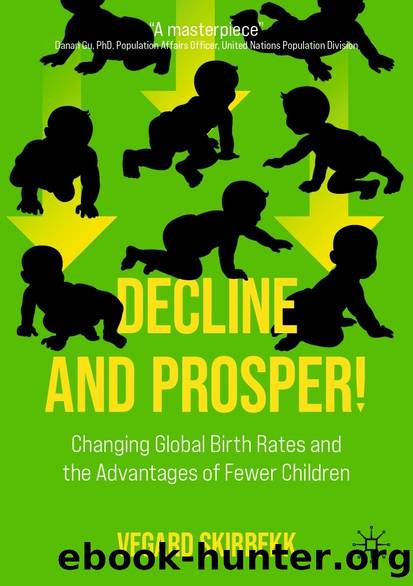Decline and Prosper! by Vegard Skirbekk

Author:Vegard Skirbekk
Language: eng
Format: epub
ISBN: 9783030916114
Publisher: Springer International Publishing
Education Decisive for Fertility Postponement
Family planning programs between the 1990s to the mid-2010s have been related to substantial reductions in adolescent fertility [22]. Nevertheless, many popular interventions aimed at improving adolescentsâ reproductive health (and reduce unintended adolescent births) have proven ineffective [23]. In contrast, there is little controversy that young womenâs educational attainmentâespecially their secondary school attendanceâis closely related to adolescent fertility. In both developing and developed countries, more education (as reflected in more years of schooling and/or higher enrolment rates) is associated with lower teenage fertility, also in quasi-experimental studies on the effects of universal extensions to compulsory education [24â29]. The study on an education reform in Norway cited earlier found that one additional year of schooling reduced the chance of teenage pregnancy by eight percentage points [28]. Increasing the length of compulsory education in Turkey [29] and Argentina [30] had similar effects on teenage fertility. Other studies based on data from over 50 low- and middle-income countries found that the proportion of women aged 15â24 studying was inversely related to the proportion who were married or mothers [31, 32], while another found that decreases in adolescent fertility between 1990 and 2012 were greater in countries where national income grew more, educational expenditure increased, and there were better job opportunities and less income inequality [33].
While most scholars agree that young womenâs educational attainment is associated with particularly adolescent fertility, whether education causes teenage fertility (and if so, how) is still a matter of debate. One Argentinian study found evidence that education has both a âhuman capital effectâ (whereby one additional year of schooling causes a decline of 30 births per 1000 girls) and also a weaker incarceration effect (whereby an increase of one percentage point in the enrollment rate reduces 3 births per 1000 girls) [30]. Another primary mechanism by which education appears to affect adolescent fertility is by delaying marriage [32, 34]. A Senegalese study, for instance, found that women tend to delay marriage until they have completed school; hence, longer schooling is associated with a delay in the timing of marriage and thereby also childbearing [34].
No matter how much pressure [my family] may create, I do not want to have any children for 2-3 yearsâ¦. This is because I am still a student. I am not even earning any money, and my wife is a studentâ¦. Therefore, I think that if my wife becomes a mother, her entire time will be spent in nourishing her child. She wonât have any time for her educationâ¦. I tell my wife not to be under any pressure and to study as long as she wants toâ¦. My parents are uneducated, and the trend in this village is to give birth immediately after getting married. My parents want me to follow the trend. If my wife doesnât get pregnant, people will start talking against her and may question her fertility.â
âA newly married man in Nepal, aged 21, on why he wants to delay having his first child [35]
Download
This site does not store any files on its server. We only index and link to content provided by other sites. Please contact the content providers to delete copyright contents if any and email us, we'll remove relevant links or contents immediately.
Cecilia; Or, Memoirs of an Heiress — Volume 1 by Fanny Burney(32495)
Cecilia; Or, Memoirs of an Heiress — Volume 2 by Fanny Burney(31909)
Cecilia; Or, Memoirs of an Heiress — Volume 3 by Fanny Burney(31893)
The Great Music City by Andrea Baker(31757)
We're Going to Need More Wine by Gabrielle Union(19003)
All the Missing Girls by Megan Miranda(15777)
Pimp by Iceberg Slim(14433)
Bombshells: Glamour Girls of a Lifetime by Sullivan Steve(14021)
For the Love of Europe by Rick Steves(13566)
Talking to Strangers by Malcolm Gladwell(13290)
Norse Mythology by Gaiman Neil(13278)
Fifty Shades Freed by E L James(13186)
Mindhunter: Inside the FBI's Elite Serial Crime Unit by John E. Douglas & Mark Olshaker(9263)
Crazy Rich Asians by Kevin Kwan(9221)
The Lost Art of Listening by Michael P. Nichols(7453)
Enlightenment Now: The Case for Reason, Science, Humanism, and Progress by Steven Pinker(7272)
The Four Agreements by Don Miguel Ruiz(6700)
Bad Blood by John Carreyrou(6581)
Weapons of Math Destruction by Cathy O'Neil(6214)
